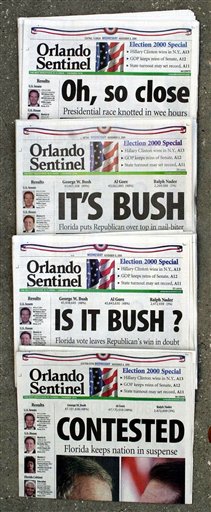



WASHINGTON — It’s a nationwide election, but the 2016 presidential race will more than likely come down to a few states. They’re called the battlegrounds, and political scientists in each of five hotly contested states explain what Hillary Clinton and Donald Trump are looking to achieve — and what they’re up against.
Ohio
The history is clear: Not since John F. Kennedy in 1960 has a presidential candidate won the White House while losing Ohio. And this year, the Buckeye State expects to once again be in the middle of a fierce battle for its 18 electoral votes.
“In the last four elections, from 2000 to 2012, the average margin of victory has been just over 3 percent, which is just about 178,000 votes,” said Dan Birdsong, lecturer in the Political Science Department at the University of Dayton.
He says voter enthusiasm — or lack thereof — will be a key factor this year, and there will be an intense focus on Ohio and the other battleground states.
“Enthusiasm and interest is only going to grow as more visits occur from the main candidates, more of the advertisements come and more of the ground game that starts driving out the turnout.”
Hillary Clinton won the Ohio Democratic primary by 14 percent over Bernie Sanders. Donald Trump finished 11 points behind the Republican primary winner, Ohio Gov. John Kasich.
More than 67 percent of Ohio’s registered voters cast ballots four years ago — far above the national turnout of 57.5 percent. But Birdsong wonders about this year.
“They’re debating among themselves about whether or not they’re going to vote — and if they do, whether or not they’re going to support Trump or Clinton. So it becomes a harder thing to predict when it comes down to that actual vote.”
Birdsong says Ohio’s racial demographics may also play a big part in keeping the race close — and unpredictable.
“(The Ohio electorate) is whiter than the national average. When you look at a place like Florida, it has a larger nonwhite population. Because of [Ohio’s] larger white population … we’ll probably see a more competitive election here than in other places.”
A key down-ballot race also may bring otherwise-apathetic voters to the polls: Republican Sen. Rob Portman faces a strong challenge from former Rep. Ted Strickland, a former governor. Recent polls have Strickland leading, but just outside the margins of error.
North Carolina
The best media bang for the campaign (or PAC) buck this year? Try the Tarheel State.
“If you are looking for your campaign to make a difference in the outcome, then North Carolina is a great place to focus resources,” said Steven Greene, professor of political science at North Carolina State University.
“In North Carolina, there’s a very clear opportunity that the resources spent here could tip the state one way or the other.”
North Carolina’s 15 Electoral College votes went to Mitt Romney in 2012 and to Barack Obama in 2008 — both very narrow victories. Greene says North Carolina remains a 50-50 state, despite solid Republican control of state politics for most of this decade.
“Republicans were very successful in (in 2010),” said Green. “They were able to take that success and gerrymander themselves into a bunch of safe districts that have allowed them to essentially take over state-level politics, despite the fact that … the voters in this state are still very much divided 50-50.”
North Carolina Democrats may not be all the energized by Hillary Clinton, but they see the 2016 race as their best chance to regain some power in the State House, thanks to the concurrent races for a Senate seat and for governor.
“Most states do not have their governors up in presidential election years. But North Carolina does. So that is going to be a very interesting, hotly contested race.”
Incumbent Republican Pat McCrory is running for re-election against the state’s longest-serving attorney general, Democrat Roy Cooper. Polls taken over the summer went both ways, putting the Real Clear Politics Average within 0.3 percent of being a literal tie.
But Greene said a change at the governor’s mansion may be as good as Democrats can hope for this year.
“(It would) very much change the nature of state politics by at least having a Democratic governor. Changing the legislature, given the districts, seems like it would be a hard go.”
Tarheel Democrats also hope to do their part in changing the majority in the U.S. Senate. Greene says it’s a bad news/good news scenario for Democrats. The bad news is the candidate: former State Rep. Deborah Ross.
“Democrats did not get … a strong — or certainly a well-known, established candidate as they would like for that race.”
But the good news for Democrats, according to Greene, is the very top of the GOP ticket: Donald Trump.
“I think, among Republicans, there probably is a real fear that having Trump at the top of the ticket puts him in more danger than he otherwise would have been.”
“He” is Republican incumbent Sen. Richard Burr. Most summertime polls showed him leading Ross by anywhere from 1 to 7 percent; the latest, however, shows Ross up by 2.
As in so many other states, Nov. 8 will come down to turnout — especially among Democrats, Greene said.
“It’s a matter of: are the Democrats able to get out enough of the minority voters and the young voters?”
But what about the iron grip Republicans have on their redrawn districts?
“You can’t gerrymander a state.”
Pennsylvania
Like other experts in other battleground states, Dan Hopkins says his home of Pennsylvania looks a lot like America.
“We have basically the same median income as the country,” said the associate professor of political science at the University of Pennsylvania. “We have more white voters, slightly fewer Asian and Latino voters. But overall, the demographics of this state look a lot like those of the country as a whole.”
He called Pennsylvania “not just ‘a’ battleground, but potentially ‘the’ quintessential battleground,”
Except when it isn’t.
With 20 electoral votes, the Keystone State has supported the Democratic Presidential candidate since 1992. Before that, voters went for Republicans Ronald Reagan and George H.W. Bush.
This time, Hopkins says, it may be more about voting against a candidate than for one.
“Negative emotions are powerful motivators. People are more likely to get up off their couches if they see something they don’t like — something they want to stop, something they’re worried about. That could be a great way to understand this election.”
Pennsylvania is also a highly partisan state, with only about 20 percent of its 2012 voters considered independents. That was the lowest percentage of all the 2012 swing states.
In the same year, Pennsylvania had the highest percentage of registered Democrats (45 percent) and Republicans (35 percent).
And while it may seem like there are very few voters left to persuade one way or the other, Hopkins contends that every voter who’s still on the fence is golden.
“Every time you persuade a voter, you get not just get their vote, but you take their vote out of your opponent’s column. Even though there are relatively few people out there to persuade, I think the fact that Trump is somewhat of an unusual candidate is going to scramble allegiances, and encourage the candidates to be out there trying to persuade voters.”
But Hopkins holds up a tiny light against the dark chaos of the race so far.
“Pennsylvania is a battleground precisely because it looks so much like the country as a whole. And it’s a reasonable battleground. A candidate who can win in Pennsylvania is a candidate who appeals broadly to the country as a whole.”
Florida
Crucial for Hillary Clinton. Absolutely vital for Donald Trump.
“It always has been essential for Republicans. To capture the White House, they have to win Florida,” said Susan MacManus, political science professor at the University of South Florida.
“Florida is always a battleground state. When you define what is a battleground state — or a swing state — first of all, that state usually votes with the winning candidate nationwide. Florida has done that every year since 1964, with the exception of one.”
Also, victories in Florida have been razor-thin. George W. Bush won in 2004 with 52.1 percent of the Sunshine State’s vote — and that’s been the largest margin of victory since 1996.
While the wins have been close, they are essential: With 29 electoral votes, Florida represents more than 10 percent of the 270 votes needed to win the White House. And the two states with more, California (55) and Texas (38), haven’t been ‘in play’ for decades: California last went for a Republican in 1988 when Ronald Reagan’s Vice-President, George H.W. Bush, topped the ticket. The last Democrat that Texas backed was a fellow Southerner, Jimmy Carter, in 1976.
History also is on Florida’s side: In the past 40 years, a candidate has won Florida but lost the White House only once — George H.W. Bush in 1992. Florida’s electoral votes went to Barack Obama twice, George W. Bush twice and Bill Clinton just once (1996). Before Clinton’s re-election, Florida rang up a four-cycle streak for the GOP.
But this year, MacManus says, the two major candidates aren’t just battling each other. A formidable Election Day foe for both Clinton and Trump will be the couch.
“There is a decision: Will they vote at all? And that’s an alarm to both parties. And how will the millennials vote — who are particularly Sanders supporters? Are they going to warm up to Hillary Clinton, or are they going to stay home?
“The ‘Never Trump’ people in the Republican Party — are they going to ultimately warm up to him, or are they going to stay home? So the key here is: What percentages of each of these are not persuadable — even to vote?”
While the disgruntled may never get to the polls on Nov. 8, both sides hope that one key down-ballot race will help. Marco Rubio’s late decision to stand for his Senate seat may persuade a few more Republicans to vote. Democrats are using the “take back the Senate” argument to counter Rubio’s popularity.
Another wild card, according to MacManus: Florida’s changing demographics.
“Florida is the microcosm of the country. If you put side-by-side statistics on the racial and ethnic makeup of America at large, Florida looks more like that any other big swing state. The same is true for religion.
“And, unbeknownst to a lot of people outside of our state, this is no longer just an elder state. The millennials plus the Gen-X’ers now make up around 47 percent of Florida’s registered voters. It’s a very different electorate out there … than people outside of Florida know.”
Finally, there are the voters who are persuadable. “Around one-fourth of our electorate is either a minor party or no party affiliation,” said MacManus. “They tend to be younger, relatively new voters. In the past, they’ve been the swing vote, tipping in one direction or another.”
Nevada
It’s only six electoral votes, but they might mean a lot. Nevada has been getting a lot of attention in this Presidential campaign because both sides believe they can win those votes.
Or maybe not.
“People call us a purple state. I think we’re a ‘lean blue’ state, based on what happened in 2008 and 2012,” said Jon Ralston, a veteran journalist who’s covered Nevada politics for more than 30 years.
Nevada voted for Barack Obama in those elections. It helped elect and re-elect both George W. Bush and Bill Clinton. Before Clinton, Nevada went Republican in every cycle back to 1968.
Ralston says the key to winning Nevada will be turnout – and turnout will depend on voter registration.
“Voter registration is very much favoring the Democrats. The Democrats have a real field operation. Republicans have absolutely nothing. Registration is not destiny, but it means a lot.”
While Trump may not be faring well at the moment, Ralston says he could get help down the ballot.
“In the Senate race, there’s organization. Joe Heck’s a very, very good candidate. He’s been able to organize in the past. He’s won against Democrats the last two times very handily.”
On the other hand, Democrats are looking to make history by electing Catherine Cortez Mastro — who would be the first Latina in the U.S. Senate.
“Hispanic turnout’s going to be significant,” said Ralston.
Trump also could benefit from the expected crush of voters opposed to Proposition 1, a ballot initiative that would require that all private gun sales be conducted through a licensed dealer — who would conduct a background check.
But Ralston believes that down-ballot candidates could also benefit Democrats — especially two House seats now held by Republicans.
“(In) one Congressional race, a Republican is almost certainly going to lose. He’s essentially an accident of history in 2014, when the Democrats had a disaster. The other is a swing seat that is either a toss-up or slightly leans toward the Democrats.”




